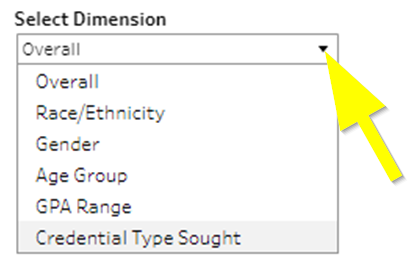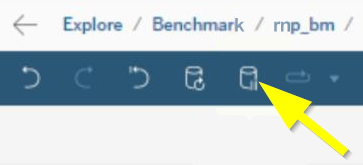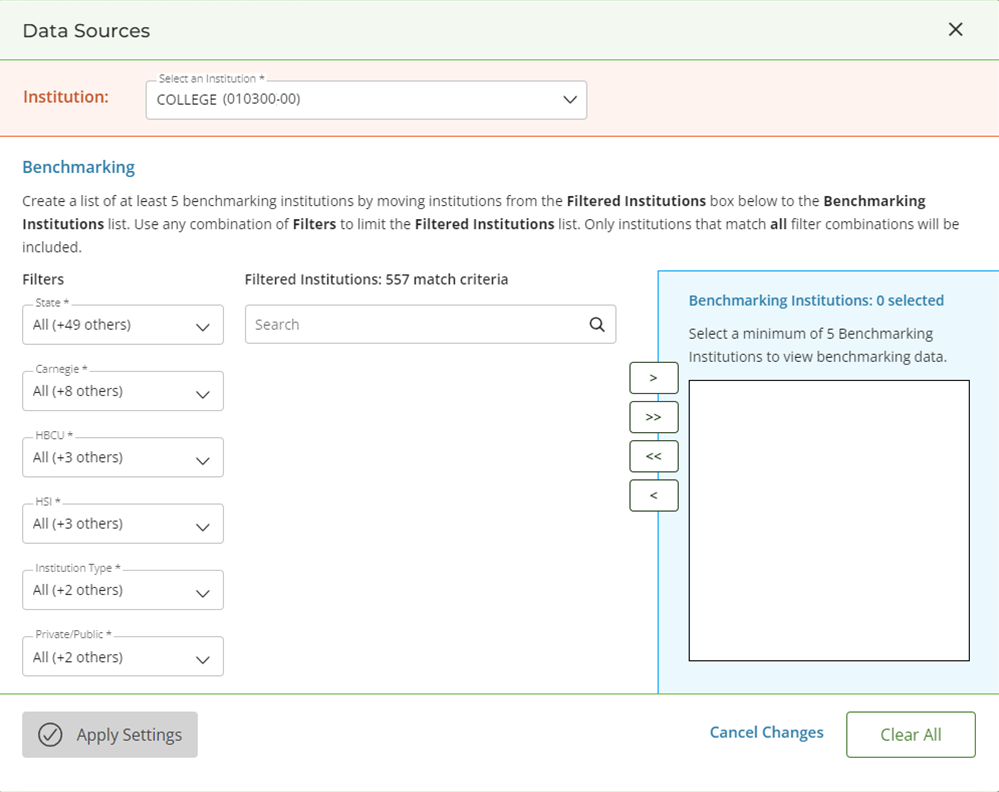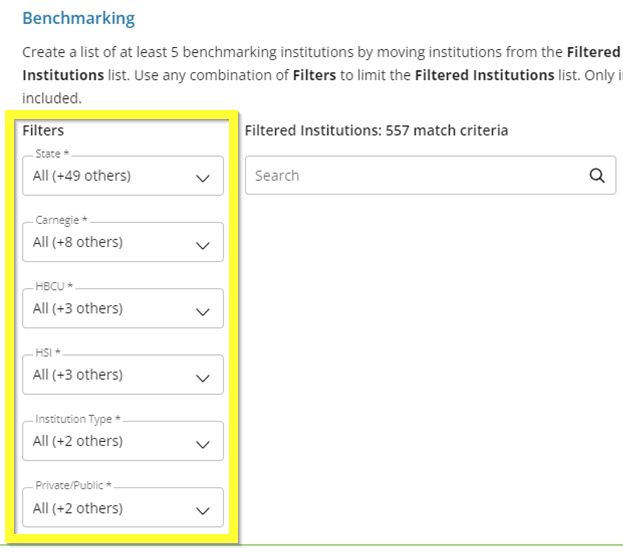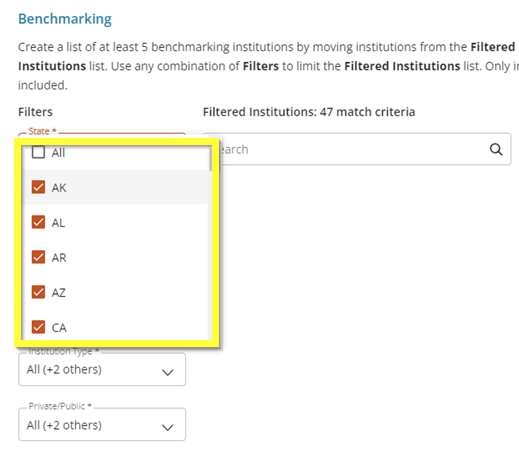Table of Contents
The Retention and Persistence Benchmarking dashboard provides a view of first-to-second-year retention and persistence rates for students who attended your institution as first-time or transfer-in students by cohort year as compared to benchmarking institutions. The dashboard displays first-to-second-year retention and persistence rates for up to eight consecutive student cohorts.
How It Works
- Retention = How many students are still enrolled or have earned a degree from your institution before the end of their second academic year
- Persistence = How many students are still enrolled in their second academic year or have completed a credential at another institution
The dashboard first checks whether a student has attempted credits at the cohort institution in their second year using the data submitted in your institution’s course data file. If you did not submit the student in your institution’s course data file during their second year, the dashboard then checks The Clearinghouse’s other enrollment and degree reporting services. If the student was submitted through another Clearinghouse service as having been enrolled at your institution during their second year, the dashboard will classify the student as retained. If another institution has submitted an enrollment record for the student, the dashboard will classify the student as persisted.
Since retention and persistence are measured over a student’s entire second year, a student could be retained in the first term of their second year and then persisted at another institution during their second term. In this case, the dashboard would classify the student as retained.
Dashboard Sections
Summary
The summary at the top of the dashboard displays the retention and persistence rates of the cohort institution compared to the benchmarking institutions. Click the number of benchmarking institutions to see a list of the institutions the dashboard is using for benchmarking. After you apply filters to the dashboard, this list will display which benchmarking institutions remain.
Total Retention/Persistence Year-Over-Year by Dimension
You can use this section to compare your institution’s overall retained or persisted, persisted only, or retained only rate against benchmarking institutions. Click one of the boxes above the graph to select a dimension.
You can also disaggregate the rate across different student dimensions. Select a dimension from the Select Dimension drop-down. Dimensions only apply to the Total Retention/Persistence Year-Over-Year by Dimension section of the dashboard. To clear a dimension, select Overall from the Select Dimension drop-down.
When you select a dimension, you’ll see multiple rows in the graph, each with two lines representing the cohort institution and benchmarking institutions. For example, if you select the GPA Range dimension, the graph will show retention/persistence rates for each GPA range.
You can also click a category on the left side of the graph to view more detailed information in the Retained, Persisted, and Not Enrolled section below.
Retained, Persisted, & Not Enrolled
You can use this section to compare the percent retained, persisted, and not enrolled at the cohort institution versus the benchmarking institutions for the available cohorts.
Global Filters
You can use the global filters to select the cohort and refine the students the dashboard includes. Global filters apply to the entire dashboard.
The global filter options are hidden by default. Click Apply Global Filters to view them. Click the X to re-hide them.
Benchmarking Data Sources
You can use this section to refine the list of institutions the dashboard uses for benchmarking. These selections apply to the entire dashboard. When you first open the dashboard, you must select benchmarking data sources in order for the data to show.
If you would like to apply both global filters and benchmarking filters, select the benchmarking data sources first, then apply the global filters.
- Click Edit on the Data Sources menu.

- If your account is part of a system of institutions or a third party organization, select a cohort institution from the Institution drop-down.

- Select your benchmarking institutions from the PDP participating institutions by filtering and/or searching. See below for details.
You can use filtering in combination with searching. For example, if you find a few institutions by searching and want to add more with similar institutional characteristics, you can use filters to find and select them.
- To add a single institution to your benchmarking institutions list, click the Add
 button. To add all of the filtered institutions to your list, click the Add All
button. To add all of the filtered institutions to your list, click the Add All  button.
button. - To remove a single institution from your benchmarking institutions list, click the Remove
 button. To remove all institutions from your list, click the Remove All
button. To remove all institutions from your list, click the Remove All  button.
button. - When finished, click Apply Settings.
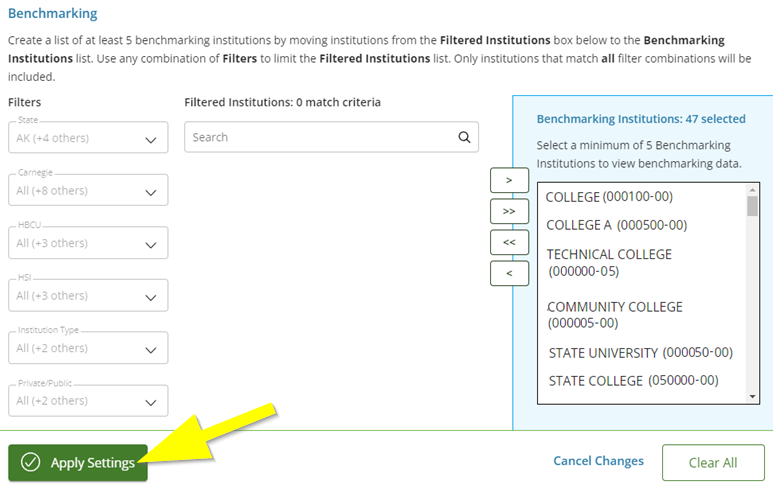
You must select five benchmarking institutions in order to save your selections. If you have selected less than five institutions, the Apply Settings button will be disabled and you will not be able to save your selections.
Searching for Benchmarking Institutions
You can search for an institution by name or OPEID.
- Click in the Search box. If you have not applied any filters, you will see a list of all available PDP participating institutions.
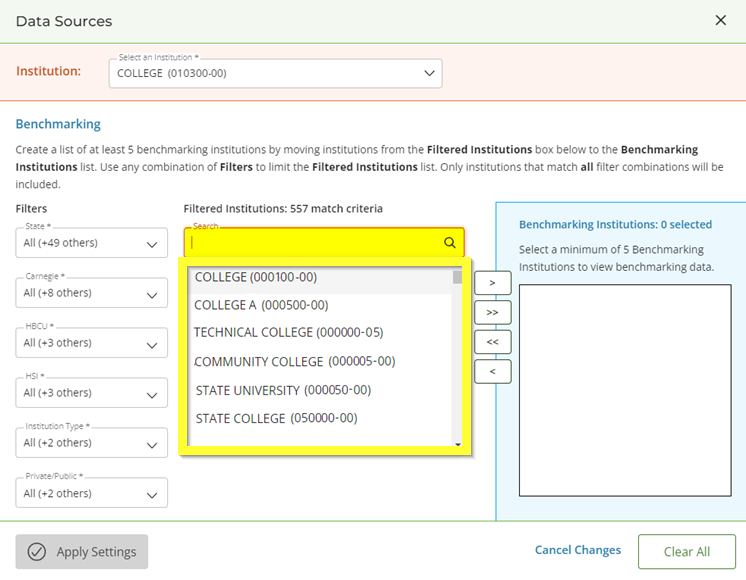
- Start typing an institution name or OPEID to narrow down the list.
- Select the institution(s) you would like to add to your benchmarking institutions list.
Filtering Benchmarking Institutions
You can use the benchmarking filters to select institution(s) that meet certain criteria by selecting or deselecting values from Filters menu. The filters will be applied to the list of filtered institutions as you select them.
Filter Options
- State: State in which the institution(s) are located
- Carnegie: Institution(s) classified by the Carnegie Classification system – rolled up
- HBCU: Historically black colleges and universities
- HSI: Hispanic-serving institutions
- Institution Type: 4-Year, 2-Year, or All
- Public/Private: Public, Private, or All
Troubleshooting No Data
There are two reasons why the Retention and Persistence Benchmarking dashboard might show no data:
- Low Cell Size Suppression: Low cell size suppression or missing and/or incomplete data can cause graph to display zero percent or missing data points. Remove one or more filters.
- Not Enough Cohort Students: The dashboard requires at least 11 students to show student outcomes data. You may have filtered the students in the selected cohorts down to less than 11. Remove one or more global filters.



